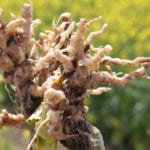CALGARY — Agronomists thought fields infected with clubroot would take years to get back into safe canola-growing shape. Now they think an infected canola field can probably return to canola production after a two-year break. And a standard three-year rotation (canola-other crop-other crop) should be able to keep clubroot contained even if it’s present. “If […] Read more
Tag Archives clubroot

Clubroot threat hangs over Sask. farmers
Agricultural Producers Association of Sask. delegates examine ways to fight the disease as it spreads into their province
Saskatchewan farmers are watching the spread of clubroot with alarm. The release of the province’s distribution map early next year will only confirm what many already know: the canola disease is closer and more prevalent than they thought. Delegates to the Agricultural Producers Association of Saskatchewan annual meeting held late last month said they hoped […] Read more
Nothing fancy about killing clubroot
Household bleach works as well as specialized disinfectants, say experts — and it’s cheaper, too
A jug of household bleach is an important tool in the fight against clubroot. Studies by Alberta Agriculture crop pathologist Michael Harding, which compared different disinfectants that can be used on farm equipment, showed a 50:50 concentration of common household bleach and water killed spores and is cheaper. A few years ago, Virkon disinfectant was […] Read more
Clubroot raises its profile in Man.
In the fall of 2015, clubroot galls were discovered in a canola field near Swan River, Man. It was the first confirmed case of clubroot with visible symptoms of the disease in Manitoba. Three years later, more than 30 canola fields in Manitoba have plants with clubroot galls, and the cases have spread well beyond […] Read more

Frustration mounts over clubroot’s spread
RED DEER — With no sign of slowing down, clubroot’s big spread isn’t only hurting yields — it’s got some worrying over canola’s ability to remain productive in the long run if more isn’t done to handle the issue. The soil-borne disease has grown exponentially since it was first discovered in 2003 near Edmonton. Last […] Read more

Clubroot makes debut in Peace Region canola
Clubroot has now climbed into the Peace region — and its recent discovery will change the way canola farmers operate in the area’s southeastern corner. Alberta Canola announced Aug. 23 that one case of the serious soil-borne disease was found in a canola crop in Big Lakes County, which surrounds much of Lesser Slave Lake. […] Read more

Canola council changes emphasis on clubroot message
DAUPHIN, Man. — In an ideal world, every Canadian would jog, bike or swim four days a week. But that’s unlikely to happen so it’s probably better to recommend something easy, like ordering a salad instead of poutine at lunch. Similarly, for years plant pathologists and agronomists have told prairie farmers to thoroughly wash and […] Read more

Clubroot control could be helped by adding field exits
DAUPHIN, Man. — In February, Dan Orchard had a eureka moment. Orchard, a Canola Council of Canada agronomist in central Alberta, spends a lot of time thinking and talking about clubroot because the disease affects hundreds of farms in his area. Earlier this winter, after speaking to a grower on the phone, an idea popped […] Read more




